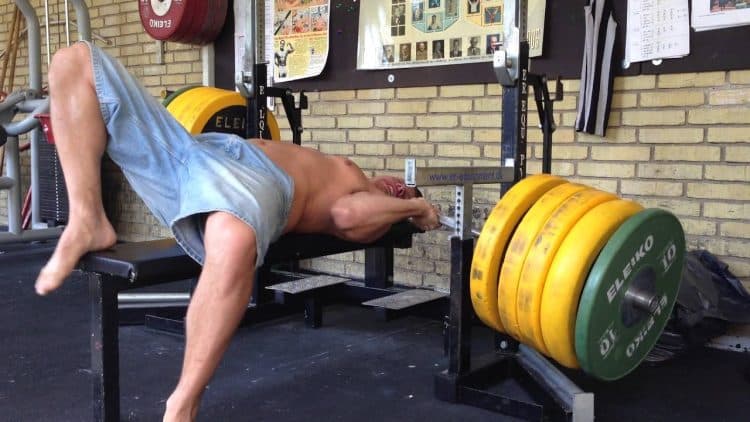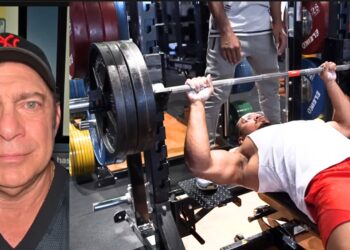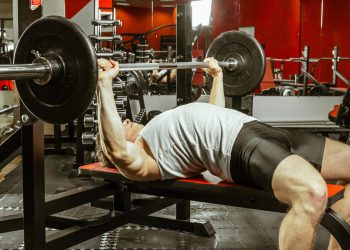The barbell flat bench press, from this point onward referred to simply as the bench press, is one of the most commonly performed exercises in gyms today. It’s popular with bodybuilders, who use it to build bigger pecs, and athletes who want to get strong for their sport.
It’s often used as a test of upper body strength, and on discovering that you lift weights, many people will want to know, “how much can you bench?”
As well as being a popular bodybuilding exercise, the bench press is also one of the lifts contested in the sport of powerlifting, and is occasionally featured in strongman events.
Surprisingly, the bench press is a relatively new exercise. Before the 1930s, most pressing was performed either from standing or while lying on the floor – the so-called floor press.
As the bench press is so popular, it’s only right that you learn to do it properly because good technique can be the difference between getting a lot from this seemingly simple exercise and permanently damaging your shoulders.
So, in this guide, we explain why and how to do bench presses and the variations and alternatives you can do instead.
Level Up Your Fitness: Join our 💪 strong community in Fitness Volt Newsletter. Get daily inspiration, expert-backed workouts, nutrition tips, the latest in strength sports, and the support you need to reach your goals. Subscribe for free!
Bench Press – Muscles Worked
The bench press is a compound upper-body exercise. As such, it involves two joints and multiple muscles working together. The main muscles trained during the bench press are:
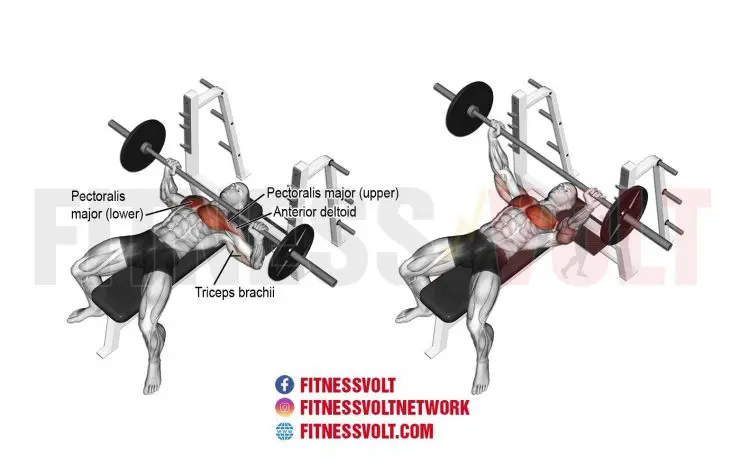
Pectoralis major
Known as the pecs for short, this muscle is the agonist or prime mover during bench presses and the reason that most people do this exercise. The pecs are a large, fan-shaped muscle that covers much of your chest. Its main functions are horizontal flexion, flexion, and medial rotation of the shoulder joint, and protection of the shoulder girdle.
The pecs are made up of three sets of fibers, or heads. Each can be emphasized by adjusting the angle of your bench or moving your hands closer together or further apart.
The three pec heads are:
- Clavicular head – the upper pecs
- Sternocostal head – the middle pecs
- Abdominal head – the lower pecs
Deltoids
The deltoids are your shoulder muscles. Like the pectoralis major, there are three heads that make up the deltoids – anterior (front), medial (middle), and posterior (rear). During the bench press, the anterior deltoid head is the most active, and the medial and posterior heads act mainly as stabilizers, preventing unwanted movement of the shoulder joint.
Triceps brachii
Known as the triceps for short, this muscle is located on the back of your upper arm. It is responsible for extending your elbows during bench presses. The bench press is an excellent exercise for increasing triceps strength, especially when performed with a narrow grip.
In addition to these structures, the muscles of your core, upper back, and even the legs also work hard to ensure you have a stable base from which to push. However, the training effect on these muscles is minimal.
How to Do the Bench Press
For such a seemingly simple exercise, the bench press is actually quite a technical lift – especially if you want to avoid short- and long-term shoulder, elbow, and wrist problems. Good technique will also allow you to lift more weight and/or perform more reps.
Follow these steps to make sure you are bench pressing correctly.
- With the barbell supported by the catching hooks on your bench, lie down so that your eyes are directly beneath it.
- Reach up and grasp the bar. Your hands should be slightly wider than shoulder-width apart so that your forearms are vertical at the bottom of the movement.
- Wrap your fingers and thumbs around the bar and grip it tightly. A firm grip will activate the muscles in your forearms that stabilize your wrists.
- Press your glutes, upper back, and head into the bench and push your feet into the floor. Brace your core. This will create a slight arch in your lower back. The more tension you generate in your body, the more stable you’ll be and the more weight you’ll be able to lift.
- Unrack the bar and then hold it directly over your shoulders. Note the bar’s position in relation to the ceiling; this is your start and finish point for each repetition. Make a conscious effort to return the bar to this spot at the end of each rep.
- Take a big breath in, fully inflating your chest.
- Bend your arms and lower the bar down toward the highest point of your chest. The descent of the bar should be controlled but not super-slow. As you lower the bar, tuck your elbows in towards your torso. The barbell should follow a slight curve from over your shoulders down toward your sternum.
- Let the bar lightly touch your chest. Imagine there is a plate of glass resting on your chest, and while you want to touch it, you mustn’t break it, so no bouncing.
- Without pausing, drive the bar up and off your chest and back toward your shoulders. Try to lift the bar faster than you lowered it. As the weights get heavier, this will become impossible, but if you think about doing this, you are less likely to get stuck with the bar across your chest.
- Push the bar all the way back up to the starting position and then exhale.
- Inhale, reset your core, and perform another repetition.
- On completion of your set and with the weight held over your chest and arms fully extended, push the bar back to the catching hooks. Do not try to complete your least rep and simultaneously push the bar back onto the hooks. If you miss, the bar could come crashing down on your chest.
Common Bench Press Mistakes to Avoid
Most bench press problems start when you fail to adopt the correct starting position. So, make sure you always plant your feet firmly on the floor, engage your leg muscles, arch your lower back, lift your chest, and pull your shoulders down and back BEFORE unracking the bar.
That said, watch out for the following common faults to ensure every bench press you do is as sage and effective as possible!
No lower back arch – this is usually a problem for people who perform the bench press with their feet elevated. Don’t do this!
Not arching tends to push the shoulders forward and robs you of essential shoulder stability. If you can’t comfortably plant your feet flat on the floor, the bench is probably too high. Raise the level of the floor by using some weight plates or the top of a step box but make sure that you can still create a solid lower back arch.
However, there is no need to arch your lower back so much that your abs are higher than your chest. This may allow you to lift more weight but reduces the range of motion, making the exercise less effective.
Wrists bent back – over extended wrists suggest that you aren’t gripping the bar hard enough and that you are maybe holding it too high in your hands. Instead, the bar should sit toward the bottom of your hand, close to your thumb.
If you are lifting very heavy weights, you may want to use wrist wraps for extra support. And remember, straight wrists are strong wrists.
Uneven bar – make sure that your hands are placed equidistant from the center of the bar. Use the knurled rings to check your position. It is very common for one arm to be stronger than the other, which can result in the bar being unlevel.
If you have a left-to-right strength imbalance, place all your mental effort on your weak arm. Use your mind-muscle connection to help push your weaker side. Your stronger arm will carry on regardless. After a while, you should find your imbalance fixes itself.
Not touching the bar to your chest – not touching the bar to your chest means you aren’t using a full range of motion, so you are performing less work per rep than you ought to. You may well be able to lift more weight this way, but your chest – the target muscles of the exercise – won’t be getting as much of a workout as they should. So, full reps only, please!
Bar bouncing off the chest – this maneuver may help you lift more weight but is very dangerous and reduces rather than increases the effectiveness of the exercise. Touch your chest very lightly, imagining there is a pane of glass between your chest and the bar. Do not use your sternum as a trampoline!
Bench Press Benefits
Not sure if the bench press is the best exercise for you? Consider these benefits and then decide!
An effective chest builder
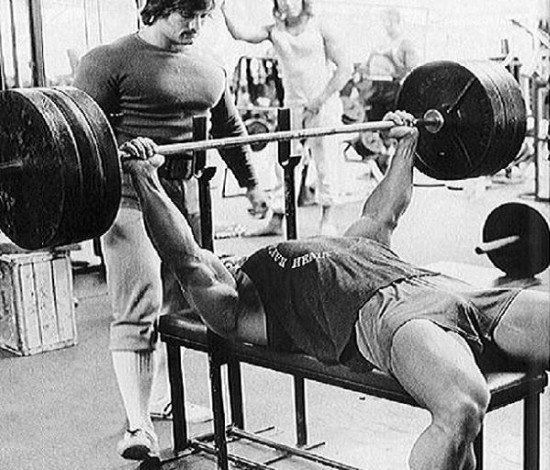
Bodybuilders all over the world use the bench press to build bigger, more shapelier pecs. There is a reason for this – it works! The bench press takes your pecs through a large range of motion and puts them under plenty of muscle-building tension. So, if you want to build the biggest, most muscular chest, the bench press probably deserves a place in your workouts.
An excellent way to develop and test your upper body pushing strength
Heavy bench presses are an effective upper-body strength exercise. They’re the second exercise contested in powerlifting events and lend themselves perfectly to lifting heavy weights. So, if you want to get as strong as possible, the bench press deserves a place in your upper-body pushing workouts.
A good exercise for most sports
Athletes from all sports include the bench press in their strength and conditioning workouts. That includes boxers, runners, soccer players, and racket sports players. In fact, the NFL uses the bench press to assess prospective draftees as part of the NFL Combine. If you play sports – any sport – the bench press will probably improve your performance.
One of the most popular exercises in the world!
This is less of a benefit and more of a statement of fact!
The bench press is one of the most recognizable exercises, and most gyms have at least a couple of bench press stations. Monday is known as national chest training day in gyms all over the world, with the bench press being at the top of everyone’s to-do list. So, get with the program and include the bench press in your chest workouts.
Drawbacks
While the bench press is a mostly beneficial exercise, there are also a few drawbacks to consider:
Some people aren’t built to bench press
Exercise is good for everybody’s body, but not all exercises are good for everybody.
If you have long arms, a shallow chest, or narrow shoulders, you may not be built to bench press. Not only will you find this exercise hard or uncomfortable, but it also may not do much for your chest development. Don’t worry, though; there are plenty of similarly effective exercises you can do instead.
It can be hard on the shoulders
The bench press can take its toll on your shoulders, especially if you fail to pack and set your shoulders correctly, lower the bar too high on your chest, or otherwise perform them badly or too often. For this reason, many lifters eventually turn away from barbell bench presses and swap them for something more shoulder-friendly, like floor presses or dumbbell bench presses.
The bench press can be dangerous
Apart from when you’re using light loads or stopping well short of failure, it’s generally best to avoid benching on your own.
A failed bench press rep can result in severe injury and even death. Once that bar is resting on your chest, it’s almost impossible to shift it. For that reason, you should always do heavy bench presses with a spotter on hand or in a power rack with the pins set at just above chest height.
10 Best Bench Press Variations and Alternatives
Bench presses are a highly effective upper body exercise, but that doesn’t mean you need to do them all the time. There are several variations and alternatives you can use to keep your workouts productive and interesting:
Level Up Your Fitness: Join our 💪 strong community in Fitness Volt Newsletter. Get daily inspiration, expert-backed workouts, nutrition tips, the latest in strength sports, and the support you need to reach your goals. Subscribe for free!
1. Incline barbell bench press
The incline barbell bench press puts more tension on the clavicular head of your pecs or upper chest. Some lifters also find it a little more shoulder-friendly, although most cannot lift as much weight as they can with flat bench presses. Stick to angles of no more than 30 degrees. More than that, and your anterior deltoids begin to take over.
Steps:
- Set your bench to 10-30 degrees. Lie on the bench with your head uppermost, eyes directly beneath the bar.
- Grip the bar with an overhand, slightly wider than shoulder-width grip. Drive your feet into the floor, push your upper back and glutes into the bench, and arch your lower back. Brace your core.
- Unrack the bar and hold it over your chest, so your arms are vertical.
- Bend your elbows and lower the bar down to your upper chest.
- Push the bar back up to arm’s length, and repeat.
Muscles targeted:
- Primary: Pectorals major (upper), anterior deltoids, triceps.
- Secondary: N/A.
Benefits:
- An excellent exercise for developing a bigger upper chest.
- Maybe more shoulder-friendly than flat bench presses.
- A valuable exercise for adding variety to your upper body workouts.
Tips:
- This exercise works best done with moderate weights and for medium reps, i.e., 60-75% of your one repetition maximum and 6-12 reps.
- Experiment with different bench angles and grip widths to see which you prefer.
- Try starting your set on a high incline and reducing it each time you reach failure for a high-to-low mechanical drop set.
2. Decline barbell bench press
The decline bench press is a popular gym exercise. It emphasizes the abdominal head of the pectoralis major or the lower pecs. This exercise also reduces your range of motion, so you may find you can lift heavier weights. Benching with a big arch, in the style of a powerlifter, replicates decline bench presses. Some lifters also find the decline bench press easier on their shoulders.
Steps:
- Lie on the decline bench, so your legs are anchored, your head is lowermost, and your eyes are directly under the barbell.
- Reach up and hold the bar with an overhand, slightly wider than shoulder-width grip. Unrack the bar and hold it over your chest.
- Bend your arms and lower the bar to your sternum.
- Extend your arms and repeat.
Muscles targeted:
- Primary: Pectorals major (lower), anterior deltoids, triceps.
- Secondary: N/A.
Benefits:
- This an effective exercise for targeting your lower chest.
- A smaller range of motion, so heavy weights can be used.
- More shoulder-friendly than flat and incline bench presses.
Tips:
- Use a narrower grip to increase triceps engagement and replicate parallel bar dips.
- Use a wider grip to increase pectoral engagement.
- Even a 10-degree decline will help increase lower pec engagement. There is no need to go too steep.
3. Floor press
Before the bench press became the world’s favorite chest exercise, the floor press was how most people did their supine pressing workouts. The floor press is still performed today, albeit usually as a bench press assistance exercise.
Steps:
- Place your barbell in a roughly hip-high squat rack. Lie on the floor beneath the bar. Bend your legs and plant your feet firmly on the floor.
- Hold the bar with an overhand, slightly wider than shoulder-width grip. Push your upper back into the floor and lift your chest up toward the bar to create a small lower back arch.
- Unrack the bar and hold it with your arms vertically.
- Bend your arms and lower the bar until your elbows/triceps lightly touch the floor.
- Push the bar back up and repeat.
Muscles targeted:
Primary: Pectoralis major, triceps, anterior deltoids.
Secondary: N/A.
Benefits:
- A very shoulder-friendly exercise.
- An effective way to work on your bench press sticking points.
- This a low-tech, high-effect exercise ideal for home lifters as no bench is required.
Tips:
- Use a narrower grip to increase triceps engagement.
- Use a wider grip to increase pectoral engagement.
- You can also do this exercise with dumbbells or a single dumbbell.
- Perform with straight legs if you prefer.
Related: Floor Press Vs. Bench Press – Which One Should You Do?
4. Close grip barbell bench press
Anytime you bring your hands closer together during the bench press, you increase the range of motion at your elbow joint, increasing triceps engagement. As such, the close grip bench press is usually performed during arm workouts. Your chest is still involved, but it plays a secondary role to your triceps.
Steps:
- Lie on the bench, so your eyes are directly beneath the barbell. Reach up and hold it with an overhand, slightly less than shoulder-width grip. Pull your shoulders down and back, brace your abs, and drive your feet into the floor.
- Unrack the bar and hold it over your chest.
- Bend your arms and lower the bar down to your sternum. Keep your upper arms tucked into your sides throughout.
- Press the bar back up and repeat.
Muscles targeted:
- Primary: Triceps, pectoralis major, anterior deltoids.
- Secondary: N/A.
Benefits:
- One of the most effective exercises for building bigger, stronger triceps.
- Emphasizes the inner chest.
- An excellent bench press assistance exercise that will improve your lock-out.
Tips:
- You can also do this exercise on an incline or decline bench.
- Touch the bar to your upper chest and push your elbows forward to increase elbow flexion and triceps engagement.
5. Wide grip barbell bench press
Bench pressing with your hands further apart increases the range of motion at your shoulders, increasing chest engagement. This was a popular exercise with old-school bodybuilders, who believed it targeted the outer pecs.
Steps:
- Lie on the bench, so your eyes are directly beneath the barbell. Reach up and hold it with an overhand grip, hands about 1½ shoulder-widths apart. Pull your shoulders down and back, brace your abs, and drive your feet into the floor.
- Unrack the bar and hold it over your chest.
- Bend your arms and lower the bar down to your sternum.
- Press the bar back up and repeat.
Muscles targeted:
- Primary: Pectoralis major, anterior deltoids, triceps.
- Secondary: N/A.
Benefits:
- A more chest-specific bench press variation.
- A good compound alternative to dumbbell flyes and cable crossovers.
- An effective way to increase off-the-chest strength for a bigger, more powerful bench press.
Tips:
- Try lowering the bar higher on your chest to increase pec activation even further.
- Add a brief pause with the bar just above your chest to stretch your pecs and make the exercise more challenging.
- Do a mechanical drop set of wide, medium, and narrow barbell bench presses – it’s a killer!
Related: Wide Grip Bench Press: A Kickass Chest Workout
6. Dumbbell bench press
As effective as the barbell bench press is, there are a few disadvantages. Problems include a limited range of motion, shoulder stress, and the potential to use one arm more than the other without realizing it. Dumbbell bench presses fix all those issues, which is why they’re such a popular alternative to the barbell bench press.
Steps:
- Lie on your bench with a dumbbell in each hand. Hold them over your chest with your hands facing down your body. Alternatively, you can use a neutral or palms-turned-in grip.
- Plant your feet firmly on the floor and lift your chest toward the ceiling.
- Bend your elbows and lower the weights out and down to the outside of your shoulders. Get a good stretch in your pecs.
- Drive the weights back up and repeat.
Muscles targeted:
- Primary: Pectoralis major, anterior deltoids, triceps.
- Secondary: N/A.
Benefits:
- With no barbell to touch your chest, you can lower the weights further and use a larger range of motion.
- Dumbbell bench presses are often more shoulder-friendly than the barbell variation.
- Using dumbbells allows you to identify and fix left-to-right strength imbalances.
Tips:
- Do incline dumbbell presses to hit your upper chest or decline to target your lower chest.
- Try close-grip dumbbell presses to increase inner chest activation.
- No bench? No problem! Do dumbbell floor presses.
7. Smith machine bench press
Smith machine bench presses are often said to be non-functional because the bar is guided by rods, and you don’t need to balance it. However, that can be a good thing because it means you are free to focus exclusively on lifting and lowering the weight and pushing your pecs to their limit. As such, the Smith machine bench press is a valuable hypertrophy exercise.
Steps:
- Position your bench so that, when you lie on it, your chest is beneath the bar. Lie on the bench and hold it with an overhand slightly wider than shoulder-width grip.
- Unrack the bar and rotate it, so it’s free to move.
- Bend your arms and lower the bar to your chest.
- Push it back up and repeat.
- At the end of the set, rotate the bar and engage the safety hooks so you can release it.
Muscles targeted:
- Primary: Pectoralis major, triceps, anterior deltoids.
- Secondary: N/A.
Benefits:
- A very hypertrophy-specific exercise.
- A safe exercise for solo trainers – no spotters required.
- No balance required, and easy to learn, so an ideal exercise for beginners.
- A very accessible exercise as most gyms have a Smith machine.
Tips:
- You can do incline, flat, or decline Smith machine bench presses.
- This exercise works best with moderate to high reps and medium to light weights.
- Do wide, medium, or narrow grip Smith machine bench presses as preferred.
8. Weighted push-up
No barbell or bench press station? No problem! You can replicate the effects of barbell bench presses with weighted push-ups. This exercise might not look much like the bench press, but it works all of the same muscles. It’s also a little more shoulder-friendly and ideal for home lifters.
Steps:
- Strap on a weighted vest or backpack loaded with water bottles, books, or weight plates.
- Kneel down and place your hands on the floor, slightly wider than shoulder-width apart and fingers pointing forward.
- Brace your core and walk your feet out and back until your legs and body are straight. Pull your shoulders down and back. Lengthen your neck, tuck your chin in, and look straight down at the floor.
- Keeping your body straight, bend your arms and lower your chest to within an inch of the floor.
- Drive your hands into the floor and push yourself back up, so your arms are extended but not locked.
- Reset your core and repeat.
Muscles targeted:
- Primary: Pectoralis major, anterior deltoids, triceps.
- Secondary: N/A.
Benefits:
- An ideal bench press alternative for home exercisers.
- No spotter required, even if you train to failure.
- A highly functional full-body exercise that develops inter-muscle coordination.
Tips:
- Start with about 10% of your body weight in your vest/backpack.
- Place your hands close together to emphasize your triceps or further apart to work your chest more.
- Place your feet on a chair or bench to put more load on your arms without adding more weight to your vest/backpack.
- You can also do this exercise using push-up handles, which is often more comfortable for the wrists.
9. Chest dip
Dips don’t look a lot like bench presses, and yet, they’re every bit as effective for building a bigger, more muscular chest. Not convinced? Check out the upper body development of the average elite male gymnast; THAT’S the power of dips! Chest dips are very similar to decline barbell bench presses.
Steps:
- Hold your dipping bars with your palms turned inward. Step up and support your weight on extended arms. Push your shoulders down and back and look straight ahead.
- Bend your elbows and lower your chest down between your hands, so you feel a stretch in your pecs.
- Push yourself back up and repeat.
Muscles targeted:
- Primary: Pectoralis major, triceps, anterior deltoids.
- Secondary: N/A.
Benefits:
- A very effective bodyweight chest exercise.
- Ideal for home exercisers who don’t have space for a barbell and bench press station.
- It can be modified to target the pecs or triceps more just by altering the angle of your body.
Tips:
- Lean forward to increase chest engagement or keep your body upright to emphasize your triceps.
- Wear a weighted vest to make this exercise more challenging.
- Stretch a resistance band between the handles and kneel or stand on it for assistance and to make dips easier.
- Do ring dips to increase chest engagement and the difficulty of your workout.
10. Chest press machine
Like the Smith machine bench press, the chest press machine allows you to focus exclusively on lifting and lowering the weight so you can push your pecs to their very limit. Most gyms have a chest press machine, and this exercise is the ideal way to finish your pec workouts. End your chest training with a few pump-inducing drop sets to ensure you’ve exhausted all the available muscle fibers.
Steps:
- Adjust the height of the seat so that, when you sit on it, the handles are level with your mid-chest.
- Grab the handles with an overhand, slightly wider than shoulder-width grip.
- Extend your arms and push the handles away from you until your elbows are straight but not locked.
- Bend your elbows and lower the handles toward you, stopping just before the weights touch down.
- Continue for the desired number of reps.
Muscles targeted:
- Primary: Pectoralis major, triceps, anterior deltoids.
- Secondary: N/A.
Benefits:
- A very safe exercise that’s ideal for training to failure.
- asy to learn and perfect for beginners.
- An excellent exercise for drop sets, burn reps, 21s, and other training-intensifying methods.
Tips:
- Experiment with grip width and seat height to see what works best.
- Try a few different chest press machines to see which one you prefer. Most gyms have several makes and models to use.
- Don’t allow the weights to touch down between reps; doing so takes tension off your pecs.
Bench Press FAQs
Got a question about the bench press or chest training in general? No worries – we’ve got the answers you need!
Is the bench press a good chest exercise?
The answer to this question is a resounding maybe! Why so? For some people, the bench press is an excellent chest exercise that produces great pec gains. But, for others, it’s a frustratingly unproductive exercise. Depending on your genetics and body type, the bench could be one of the best exercises you can do for your chest or the worst.
How can you tell if the bench press works for you?
Train it hard and heavy for 8-12 weeks and assess your progress. Then, swap it for another high-quality chest exercise, e.g., weighted dips or dumbbell bench presses, and train that exercise for 8-12 weeks. Compare your progress, and you’ll have your answer.
Are dumbbells or a barbell better for the bench press?
The barbell bench press generally allows you to lift more weight than dumbbells. Still, dumbbells allow for a greater range of motion, require more stabilizing, and are often more shoulder friendly.
Really, one is not better than the other; they’re just different. So, the best exercise is whatever matches your training needs and wants and that you enjoy the most.
Why do some powerlifters arch their backs so much during bench presses?
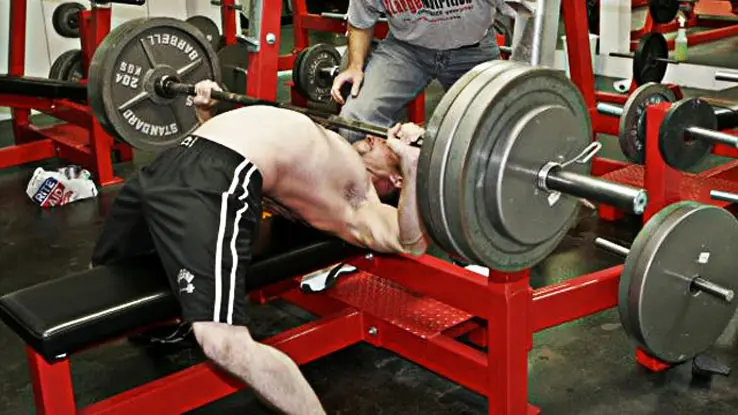
Bodybuilders and powerlifters often bench press differently because they have different training goals. Bodybuilders want to put lots of muscle-building tension on their muscles. In contrast, powerlifters want to lift the heaviest weights possible.
Powerlifters use a pronounced arch, so their chests are higher, and they don’t have to lower the bar as far. This makes it somewhat easier to lift very heavy weights. Some powerlifters can arch so strongly that they only have to move the bar a few inches to perform a meet-legal rep.
In contrast, bodybuilders want a small but solid arch, so they are as stable as possible but can still take their muscles through a large range of motion for better gains.
Interestingly, while excessive arching is legal, some powerlifting federations are phasing it out in an effort to make competitions fairer and easier to judge.
Bench presses hurt my shoulders, so what should I do?
Bench pressing puts a lot of stress on your shoulders. Depending on your joint structure, it may even cause shoulder pain. If bench presses bother your shoulders, consider replacing them with any of the following:
- Close grip bench press
- Decline bench press
- Football bar bench press
- Floor press
- Dumbbell bench press
- Weighted push-up
All of these exercises are a little more shoulder-friendly than the flat barbell bench press. But, if your shoulders still hurt, you should get them checked by a qualified medical professional, as it could be a symptom of an underlying injury.
Are weighted push-ups really as effective as bench presses?
In many ways, your body is an amazing feat of biomechanical engineering. But, despite its apparent sophistication, your body is also kinda dumb. For example, it cannot tell the difference between doing barbell bench presses or weighted push-ups.
All your body knows is muscle tension and work. So, providing you use enough weight, do enough reps, and train often enough, it really doesn’t matter that much whether you do barbell or dumbbell bench presses or strap on your weighted vest and bust out a set of push-ups.
That said, if you specifically want to improve your bench press performance, you should include plenty of bench pressing in your workouts so you can practice and master this surprisingly technical exercise.
What rep and set range should I use for bench presses?
If you want to increase bench press strength, most of your training should be in the 1-5 rep range using 85% or more of your one repetition maximum. Rest 3-5 minutes between sets and do 4-8 sets per workout.
In contrast, if your goal is chest hypertrophy, you can train with lighter weights and do anywhere from 6 to 35 reps per set. Shorter rests are also more appropriate, typically 60-90 seconds between sets. However, you should take most of your sets to within a couple of reps of failure. Easy sets do not build bigger muscles!
Regarding training volume for hypertrophy, you should try and accumulate between 10-20 sets per week for your pecs, either in one workout or spread between a couple of sessions.
How many times a week should I do bench presses?
If you are a powerlifter or just want to lift more weight, you should bench press twice a week, e.g., Monday and Thursday. This will provide you with not only the stimulus you need to get stronger but also the opportunity to practice and perfect your technique.
However, suppose your main goal is hypertrophy. In that case, you’ll probably get better results by doing two different chest workouts per week, one based around the bench press and the other using a different primary exercise, e.g., incline bench presses.
Are bench presses safe?
Bench presses are potentially one of the most dangerous gym exercises. After all, you’re holding a lethally heavy weight directly over your chest! Unfortunately, a failed bench press rep can cause severe injury, and a few people die every year in bench press-related accidents.
Make the bench press as safe as possible by:
- Training with an attentive spotter on hand.
- Bench pressing in a power rack.
- Stopping before absolute failure.
- Training with dumbbells rather than a barbell when you’re on your own.
However, performed with these safety guidelines in mind, the bench press is no riskier than the squat or most other barbell exercises. It’s just that, when it goes wrong, the bench press has the potential to do a lot of damage.
Wrapping Up
If the squat is the king of lower body exercises, the bench press holds the same title for your upper body. Very few exercises have the potential to build more chest, triceps, and shoulder mass or strength.
That said, a lot of lifters do not know how to bench press properly. As such, they get less than they should from this exercise and risk injury with every rep they do. Also, some people just aren’t built to bench press.
Get the most from bench presses by performing them correctly. And don’t despair if you are a bench press non-responder or they bother your shoulders, as there are plenty of other exercises you can do instead. The bench press is NOT compulsory!
Interested in measuring your progress? Check out our strength standards for Bench Press, Dumbbell Floor Press, Push Ups, and more.

